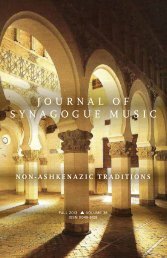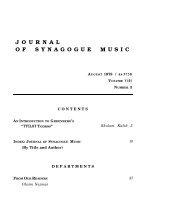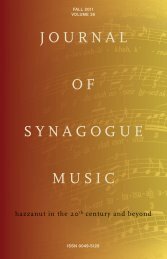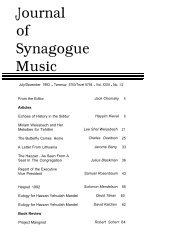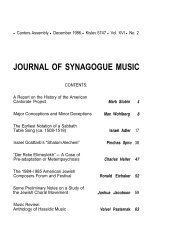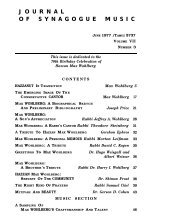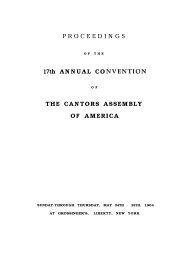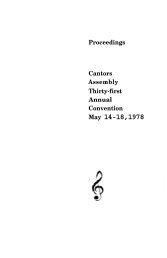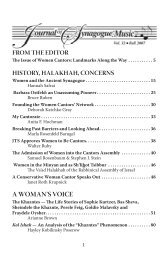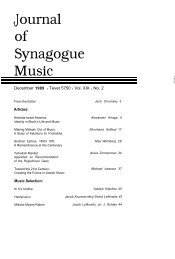ninth annual conference-convention - Cantors Assembly
ninth annual conference-convention - Cantors Assembly
ninth annual conference-convention - Cantors Assembly
Create successful ePaper yourself
Turn your PDF publications into a flip-book with our unique Google optimized e-Paper software.
children to long for an opportunity to join a<br />
group, the more eager they will be to join it.<br />
choral<br />
In the training of the Jr. Choir, the biggest problem<br />
is teaching the two sections their respective parts at<br />
the same time. While we normally follow the same<br />
procedure as we would when teaching a song by rote,<br />
we have here a situation similar to that of a tworing<br />
circus. Our attention has to be constantly focused<br />
on both sections and both have to be kept constantly<br />
on the go. Since the melodic line is easier to<br />
learn, we usually start with the counter part. The<br />
use of the piano is very helpful.<br />
Any one who plans to organize a Junior Choir will<br />
find the booklets by Judith Eisenstein and Harry Coopersmith<br />
(items 1, 2, 3) extremely valuable and informative.<br />
They contain detailed suggestions on the<br />
planning, organization, promotion and the training of<br />
such groups.<br />
Among the musical resources, which are still very<br />
limited, I have found the Choral Books by Coopersmith<br />
and the Hebrew Rounds by Shalom Altman to<br />
be very useful. Any one planning a service for the<br />
Jr. Choir will find it necessary to supplement the available<br />
material with his own two-part arrangements.<br />
The standards of the Jr. Choir musical repertoire<br />
will have to grow with the choir. In the beginning<br />
the arrangements have to be simple. A sensible use<br />
of parallel 3rds and 6ths can be very effective. Later,<br />
a good fluent counterpoint will be so much more satisfying.<br />
A good rule to follow, when arranging music<br />
for children (and for amateur groups, in general), is<br />
to make sure that the counter-part is melodious and<br />
interesting in itself and not just a meaningless sequence<br />
of notes. It is advisable to give occasionally<br />
the melodic line to the alto section. Aside from lending<br />
itself to striking musical effects, this device helps<br />
to add to the interest of the choir. The proper balance<br />
between melody and counter-melody should be<br />
stressed at all times, and notated in the music.<br />
I think it might serve a useful purpose to relate to<br />
you the case history of the development in my synagogue<br />
of a teen-age Choral Group which, I believe, is<br />
quite unique.<br />
I have always been concerned with the promotion<br />
and encouragement of greater congregational participation<br />
in the Sabbath Services since our professional<br />
choir did not take part in them. Noticing that quite<br />
a number of teen-age boys and girls attend the services,<br />
I spoke to them and suggested that they sit to-<br />
gether in the first few rows in front of me. I explained<br />
that I would like to delegate to them the<br />
responsibility of leading the congregation in song. I<br />
further explained that I was anxious to introduce,<br />
through them, additional congregational selections, and<br />
I suggested that for that purpose we ought to meet<br />
once a week for a brief rehearsal. The reaction was<br />
favorable and the following few Sabbath services gave<br />
the children a great deal of satisfaction. I then asked<br />
-22-<br />
the children if they would, in addition to singing congregational<br />
melodies, also assist me in my chanting by<br />
humming chords at pre-arranged signals. A few short<br />
experiments created a great deal of excitement among<br />
the youngsters. Within two months six new selections<br />
were added, and the group grew in size and stature.<br />
Officers were elected and the membership, that now<br />
numbered over 40 children, was made select. The next<br />
step was to divide the group into two sections and to<br />
provide for music folders with 2 and 3-part arrangements<br />
of some of the congregational melodies. Even<br />
before that I had encouraged attempts by individual<br />
members of the group to “harmonize” spontaneously.<br />
It was not the finest harmony, to be sure, but what<br />
it lacked in refinement, it made up in enthusiasm.<br />
Placing a music folder in their hands and restricting<br />
them to the discipline of a written arrangement really<br />
clinched the group and the Youth Chorale was<br />
born. The next step was to arrange some of the<br />
synagogue choir’s compositions in a simplified form<br />
for the use of the Youth Chorale. You have never<br />
seen or heard a more excited group than when they<br />
sang for the first time the Musaf K’dushuh in a 3-part<br />
arrangement!<br />
The Chorale’s plans for the next season include participation<br />
in the auditorium High Holiday services, for<br />
which they have already started rehearsing. In recognition<br />
of their services, our congregation has just<br />
awarded them with special pins and uniform caps and<br />
Talesim.<br />
I have often been told that developing this group<br />
has been my greatest contribution to my congregation.<br />
The way I feel is that I am the one who has benefited<br />
from this experience, since it enriched my life immeasurably.<br />
IV. CHILDREN’S SERVICES:<br />
The purpose of organizing separate services for<br />
children is to afford them an opportunity to get acquainted<br />
with the prayers, chants and rituals of the<br />
adult services in a manner and in circumstances that<br />
will suit their age level.<br />
The following children’s services are a common practice<br />
in many congregational schools :<br />
1. Junior Congregation (for Sabbath and Holidays).<br />
2. Mincha and Maariv services (as last part of<br />
school session).<br />
3. High Holiday Junior Services.<br />
4. Talis and T’filin Clubs (on Sunday mornings for<br />
boys 12 years old and up).<br />
5. Special services (Purim, Hanukkah, etc.).<br />
As Hazzanim, we have more of a personal stake in<br />
the proper functioning of these services than in any<br />
other activity in the synagogue, since the results of<br />
these services will have a direct bearing on the quality<br />
of our future congregants. However, due to schedule<br />
conflicts, we are rarely able to participate in them. It



